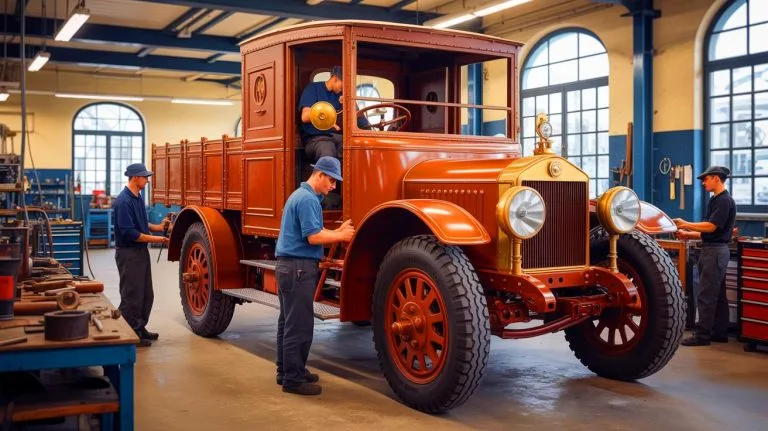| IN A NUTSHELL |
|
The restoration of historical vehicles often serves as a bridge to the past, allowing us to appreciate how far technology has come. In southwestern Germany, a fascinating restoration project is underway involving a replica of the world’s first petrol truck. Originally created by automotive pioneer Gottlieb Daimler in 1896, this replica is not just a static museum piece; it’s being brought back to life at a trade school in Nürtingen. This initiative combines historical preservation with modern educational techniques, offering a unique glimpse into the evolution of automotive engineering.
The Origins of the First Petrol Truck
Gottlieb Daimler’s foray into automobile engineering began with the creation of the first petroleum-powered vehicle: a motorcycle. This was a groundbreaking achievement at the time, setting the stage for the development of more complex machinery. The motorcycle was powered by a modest 264cc engine, producing just 0.5 horsepower. While this might seem insignificant by today’s standards, it was revolutionary at the time.
By 1896, Daimler turned his attention to constructing a truck, which was a natural next step. The prototype was powered by a more advanced 1060cc four-stroke engine, boasting 4 horsepower. Although this output might appear meager, it equaled the work of multiple horses. This innovation provided significant advantages over the bulky steam-driven engines of the era, allowing for more compact designs and efficient performance.
This pioneering truck design also featured a multi-speed belt drive system, enabling more effective power distribution. The vehicle’s engineering brilliance extended to its suspension, which utilized coil springs for the rear axle, reflecting the ingenuity of the time.
Restoration as a Learning Experience
The current restoration project of this replica involves apprentices at a trade school in Nürtingen, highlighting the importance of hands-on learning. Under the guidance of experienced instructors, these students are gaining invaluable practical skills. The project not only revives a piece of history but also serves as an educational tool for future automotive engineers.
Daimler’s initiative emphasizes the blend of tradition and modernity, encouraging intergenerational exchange of knowledge. The school, known for its excellence in both classic and modern automotive education, is an ideal setting for such a project. This approach ensures that the rich history of automotive engineering is preserved and passed down to the next generation.
The restored vehicle is scheduled to participate in the Spitzkraut Classics, an event dedicated to showcasing classic vehicles. This demonstration will mark the culmination of the students’ hard work, allowing them to witness the fruits of their labor in action.
“68 Out of 100”: Subaru Destroys Toyota and Lexus in Massive 300,000 Vehicle Reliability Study
Evolution of Truck Design
By 1898, just two years after the prototype’s creation, truck design had already begun to evolve significantly. The newer models featured a 2.2-liter engine positioned over the front axle, which was a departure from the initial design. This configuration allowed for better weight distribution and improved performance.
The introduction of Bosch magnetic ignition systems marked a significant technological leap, replacing Daimler’s earlier hot-tube ignition method. These advancements demonstrated rapid progress in automotive technology at the turn of the century, laying the groundwork for future innovations.
Such developments highlight the dynamic nature of engineering, where continuous improvement is driven by both necessity and curiosity. The progression from the original Daimler truck to its successors provides a fascinating narrative of innovation and adaptability.
The Significance of Replicas
Replicas play a crucial role in preserving history, especially when original artifacts are lost to time or disaster. The original Daimler truck, like the first motorcycle, may have been lost in a factory fire in 1903. This unfortunate event underscores the importance of creating and maintaining replicas, which serve as tangible links to our past.
Restoring and displaying replicas allow the public to engage with history in a meaningful way. These efforts ensure that the legacy of pioneering engineers like Daimler is not forgotten. Replicas also offer educational opportunities, providing hands-on learning experiences that textbooks alone cannot offer.
The current restoration project underscores the importance of replicas in historical preservation. By breathing new life into these mechanical marvels, we ensure that their stories continue to inspire future generations.
The restoration of the Daimler truck replica is more than a nod to the past; it is a celebration of innovation, education, and preservation. As we witness this historical vehicle return to operational status, we are prompted to consider the future of automotive engineering. How will today’s advancements shape the vehicles of tomorrow, and what role will history play in guiding these innovations?
Did you like it? 4.4/5 (27)







Absolutely amazing! I can’t believe they managed to bring this piece of history back to life. 🚚👏
Wow, this is amazing! I had no idea the first petrol truck was created in 1896. 🚚
Why is it important to create replicas when the original is lost? 🤔
How long did it take the students to complete this restoration project?
Such an incredible project for students! Hands-on learning at its best. 👨🏫
Is the replica fully functional? Can it actually drive?
Is it possible to see this restored truck in action, or is it only for display?
Great work on preserving history! Thank you to those students and teachers involved.
So, how long did the restoration process take?
What an incredible educational opportunity for these students! Learning by doing is the best way. 👨🏫
It’s fascinating to see how far truck design has come since 1896!
I’m curious, how did they manage to find the original plans for the truck? 🤔
Honestly, I’m not sure why we need replicas. Can’t we just look at pictures?
The original was destroyed in a fire? That’s tragic. 😢
This project is great, but isn’t it a bit risky letting students work on such a valuable replica?
Are there any other historical vehicles being restored at the trade school?